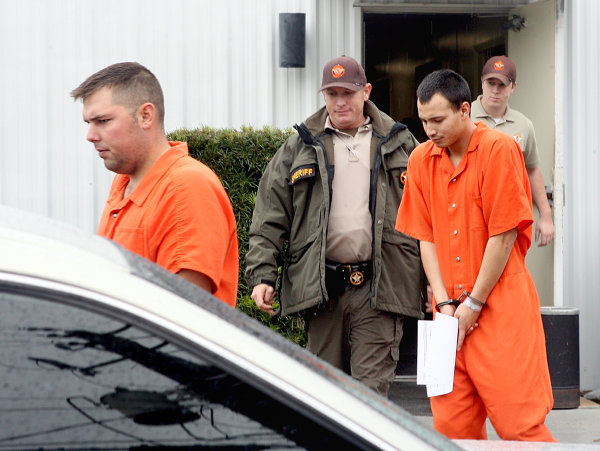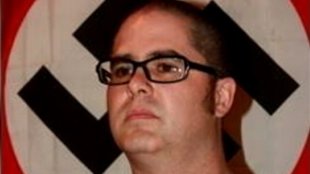Big Picture: Homegrown terrorism
Michael Roark was 19, his girlfriend Tiffany York 17, when they were shot in the head, twice, on Dec. 4, 2011, in Georgia. Both from military families, they had been dating just three months, but Roark's father Brett told AP that the two were "truly in love."
York's father, on the other hand, didn't favor the romance. A photo his daughter had sent — the couple at the shooting range, standing by a table with 15 rifles and handguns — disturbed him, he told a reporter. He wanted her to break it off. York had plane ticket bound for California, to join family there and go into nursing. In her final days, she too had reservations, wondering aloud about her boyfriend's ready cash. (She was told, reports say, that Roark and his friends earned their money working in a "business that placed holds on credit cards.")
Roark was "broken-hearted and disappointed," his father said — but not over York. The private had just left the Army, disillusioned after less than two "with what he found at Fort Stewart."
Less than a week after Roark left the Army, he and York were murdered, allegedly to hide four fellow soldiers' burgeoning militia plot to kill Americans. There has been no trial yet, but plenty of details -- alternately horrifying and bizarre -- emerged in hearings overshadowed by political conventions. According to one suspect's statement, plans for homegrown terrorism included:
- bombing a Washington dam
- poisoning the apple fields
- bombing Forsyth Park fountain in Savannah
- overthrowing Fort Stewart, their base
- blowing up a downtown Savannah fountain
- assassinate the president
Domestic terrorism
The plot confirms what some experts fear: the rise of extremism. Overall, fatal attacks of domestic terrorism is at a four-decade low, according to the University of Maryland's National Consortium for the Study of Terrorism and Responses to Terrorism.
Those numbers however exclude other acts of violence, from arson and bombings to attempted murder. The Georgia case comes after government and private monitoring groups have reported a marked rise in hate groups, especially in the Midwest, Pacific Northwest, and the Deep South. Since the beginning of the Obama administration, hate groups have grown 755 percent, according to the Southern Law Poverty Center. Besides the recession, antagonism over a black Democratic president has been cited for its rise: A known neo-Nazi Web forum, which had amassed 90,000 users over 12 years, saw an increase of 5,000 sign-ups the day after the 2008 election. By April 2009, membership had nearly doubled to 160,000.
In 2009, a Homeland Security report warned of increasing violence among white supremacists and violent anti-government groups, reminiscent of the 1990s — which peaked with the 1995 Oklahoma City bombing, a domestic plot carried out by Timothy McVeigh and Terry Nichols that injured nearly 700 and killed 168 people.
The current economic and political climate has some similarities to the 1990s when rightwing extremism experienced a resurgence fueled largely by an economic recession, criticism about the outsourcing of jobs, and the perceived threat to U.S. power and sovereignty by other foreign powers. (April 9, 2009, Department of Homeland Security)
"The history of these [extremist] groups is that they do a lot of small-scale attacks," says Daryl Johnson, the former lead DHL analyst under the Bush and Obama administrations who authored the 2009 report. That threat may be further underestimated by how they are classified. The Arizona massacre-suicide by neo-Nazi J.T. Ready, who killed his girlfriend and her family, has been reported as domestic violence, although Ready had been under an FBI criminal domestic terrorism investigation."The number of attacks have increased since 2008, and is on par with the '90s."
Disproportionately potent
On a far smaller but worrisome scale is the connection between extremism and soldiers and veterans. In the Georgia case, private Isaac Aguigui, accused of being the mastermind, allegedly recruited fellow soldiers in the 4th Brigade Combat Team of the Army's 3rd Infantry Division. He reportedly tested them with, bizarrely, a Game Informer feature about an unreleased first-person shooter, "Tom Clancy's Rainbow Six: Patriots." Soldiers who responded to the game's premise -- "beheading corporate America and overthrowing the government" -- were deemed game for his group Forever Enduring Always Ready, aka F.E.A.R.
The subject is extremely sensitive. After the Georgia arrests, Army spokesmen released statements such as "Fort Stewart-Hunter Army Airfield does not have a gang or militia problem," and "This is an isolated incident involving four soldiers and is not a reflection of the U.S. Army or Fort Stewart." In 2009, military groups accused Johnson's report of perpetuating the stereotype of the disgruntled military veteran: The political outrage led to his unit being disbanded, believes Johnson.
Soldiers and veterans may comprise only a small minority among extremists, but the problem is that their skills make them disproportionately potent. Extremists in the military receive the same specialized training as real patriots, Johnson points out: They handle classified information, and they're entrusted with protecting the nation. The self-described Republican, who has expanded his concerns in his new book, "Right-Wing Resurgence: How a Domestic Threat is Being Ignored," doesn't think that these types of people should be protected only because they wear the uniform.
"Where's the allegiance? Is the allegiance to the people or the belief system? Are you serving the country you swore an oath to serve or you putting the extremist belief first?" Johnson asks. "I think the latter is the case, that they're putting the extremist belief before the good of the country."
Letting the enemy in
Also troubling is the argument of how extreme ideology has been allowed into the military. British journalist Matt Kennard in his new book "Irregular Army: How the U.S. Military Recruited Neo-Nazis, Gang Members, and Criminals to Fight the War on Terror,"has tracked how the military has relaxed retention standards to maintain a fighting force for two wars — from raising the enlistment age and repealing the anti-gay Don't Ask Don't Tell to tolerating everything from drug abuse, corpulence, gang activity, and extremism. Misconduct discharges have also dropped, from a high of 2,560 before the wars to less than 1,500 by 2006.
The military policy on extremism has evolved since the Vietnam War, Kennard explains to Yahoo!, and "an active-duty soldier must reject active participation in white supremacy groups," but "tons of discretion is given to the commander" over discipline. His book brings up the example of a criminal Army investigation of a soldier who provided a military technical manual to an extremist group. No charges were filed, since the organization couldn't obtain the explosives and the "action commander or prosecutor indicated intent to do nothing or at least only 'action amounting to less than a court proceeding.'"
Even more frightening is how some nihilists recommend using the military to get skills: essentially, government-subsidized training for extremists. That was the advice given by supremacist Dennis Mahon, who spoke to Kennard before he was arrested and sentenced to 40 years for a bomb attack:
"[The military] are so desperate at the moment; they are going to let you in with a small swastika... The soldiers learn from unconventional warfare in Iraq and they realize that they can use that type of warfare in America, and it's impossible to stop. I tell people to learn as much as you can to improve munitions capabilities, patrolling; I want them to learn sniping and explosives, the Green Berets. Once they go in they are not supposed to tell anyone who they are." Interview with white supremacist Dennis Mahon, "Irregular Army."
Experts like Kennard and Johnson advocate a no-tolerance policy for extremists. "These extremists are entirely different than common criminals that you deal with, because they have an ideology," Johnson explains. "A criminal is in it for the money, the power, the prestige, the recognition among their criminal folk, but you have someone who thinks they have God on his side... they're going to do be more difficult to deal with."
The triggers of war and economy
One thing that all sides can agree on: Multiple deployments have traumatized soldiers. In interviews with the New York Times about veteran suicide rates-- at the rate of one per day -- the Iraq and Afghanistan Veterans of America called those deaths the "tip of the iceberg." The Coalition of Veterans Organizations asked the Pentagon to "understand on a much deeper level the trauma the troops are facing."
Kennard worries that this vulnerability could be seen as an opportunity for recruiters. "We have a lot of unstable people without an ideology, who could do awful things in the next 10, 20 years," he says. "All it takes is one of those people to decide to take it out on someone else."
And among those already committed to an extremist view, economic trying times lend too many opportunities to trigger a disaster. White supremacist Wade Michael Page, behind the August Wisconsin Sikh temple spree killings, had reportedly lost his military and civilian jobs due to excessive drinking, and his home had been foreclosed upon.
"The catalyst can be anything from a divorce bankruptcy losing your job, foreclosure, maybe the person gets attacked at the bar and gets big beat up, a big fight with a loved one or a death of a family manner," Johnson says says. "In their conspiratorial world view, that tends to be the time to put them on the course towards criminality and violence."




